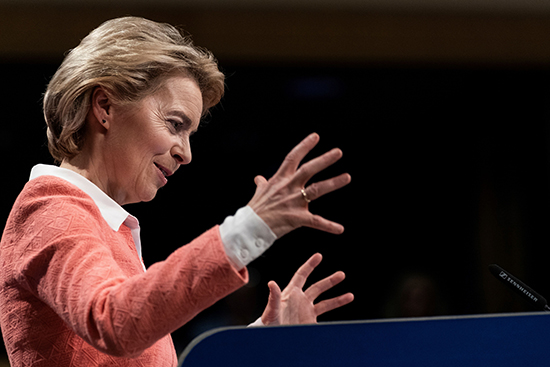夹在贸易争端和脱欧夹缝之间,欧盟调低2022年前的经济展望

|
今年11月6日,国际货币基金组织警告称,欧洲需要制定“应急计划”,避免经济持续下滑。接下来,欧盟委员会更进一步,自己将欧元区的增长目标一路下调至2021年。 欧盟对2019年的增长预期在年初时还有些乐观。春天,欧盟经济持续增长,尽管“步伐稳健”。到了夏天,这种增长“阴云密布”。如今,在发布的秋季报告中,欧盟警告称,“在高度不确定性的背景下,未来将长期经历低增长和低通胀”,激烈的贸易争端、全球经济放缓和即将到来的英国脱欧的共同影响几乎波及了经济的方方面面。 欧盟今年的GDP实际增长率为1.1%(低于去年的1.2%),通货膨胀率为1.2%。相比之下,美国经济虽然也在放缓,但预计增长率将为欧盟的两倍,即2.2%。 对欧洲来说,未来两年的前景差不多会和今年一样糟糕,预测2020、2021两年的GDP增长率仍然为1.2%。通胀在2021年之前不会再次上升达到1.3%,仍然远低于欧元区设定的接近或高于2%的目标。 欧元兑美元开盘走高,但在欧盟公布调整后的经济前景展望后,跌至负值。具有讽刺意味的是,即便是疲软的欧元——报告预测今年欧元将再贬值1%——也无法帮助这个以出口为主的区域摆脱旷日持久的衰退。也就是说,来自建筑、工业生产、金融服务、汽车和零售行业的糟糕数据共同促使欧盟下调财测。 如果你近几个月来一直关注欧洲债券市场,就会知道,当像德国国债这样通常十分坚挺的投资产品都出现负值时,一定出现了很严重的问题。报告称:“认为经济前景将继续恶化,预测将长期保持非常宽松的货币政策,加上期限溢价进一步下降,给主权债券带来了压力。” 因此产生了多米诺骨牌效应。随着投资者涌入市场寻求避险资产,欧洲AAA级国家的收益率开始跌至负值。对这些债券的需求超过了供应,现在“欧洲很大一部分主权债券的收益率为负”。 在其他地方,负利率现象降低了购房者和企业的借贷成本,但不足以刺激投资、刺激消费、促进增长。 这也重创了欧的零售银行业。对于欧洲最大的几家银行而言,低利率和平缓的收益率曲线导致它们尤其难以通过传统的商业银行业务——放贷和吸引新客户——来提高利润。 西班牙国家银行(Banco Santander)、德意志银行(Deutsche Bank)和汇丰银行(HSBC)今年均已经宣布裁员,以降低成本并度过难关。 欧洲汽车工业的表现也好不到哪去。整个欧盟对新车的需求已经停滞,同时汽车行业开始大举投资开发电动汽车和自动驾驶汽车。此外,共享汽车和打车软件的流行遏制了年轻人口中的汽车拥有量。在上述因素的共同作用下,汽车制造业的表现远低于2015年的水平。 该报告可能会引发一些人呼吁增加财政支出、提振GDP,但迄今为止,德国及其挥金如土的北欧盟友一直断然拒绝这样的建议。 但欧盟经济及金融事务总司长马可·布提于11月7日在辩论中表达了不同的思路,称负利率和低利率实际上为欧元区提供了一个通过支出摆脱衰退的特有机会。“非常低甚至负的融资成本为推出具有高社会、高环境、高经济回报的项目提供了机会。”布提说,“现在应该抓住这个机会。” 该你出招了,德国。(财富中文网) 译者:Agatha |
On November 6, the International Monetary Fund warned that Europe needed “contingency plans” to avoid a protracted decline. Today, the European Commission itself went one step further, cutting its eurozone growth target all the way through 2021. The EU’s 2019 growth outlook started the year with some optimism. In the spring, it saw continuing growth, though at a “moderate pace.” By the summer, that growth was “clouded.” Now, in the published autumn report, it’s warned of “a protracted period of subdued growth and low inflation in the context of high uncertainty,” as bruising trade wars, a slowing global economy and a looming Brexit have combined to hit nearly every sector of the economy. The EU now sees real GDP growth of 1.1 percent (down from 1.2 percent) and inflation of 1.2 percent this year. In contrast, the U.S. economy, while also slowing, is expected to grow at twice that rate, at 2.2 percent. For Europe, the outlook stays nearly as bad over the next two years with forecasted GDP growth running at 1.2 percent in both 2020 and 2021. Inflation won’t nudge up again until 2021, reaching 1.3 percent, still far below the bloc’s target of closer to 2 percent or higher. The euro, which started the day trading higher against the dollar, fell into negative territory following release of the bloc’s revised outlook. The irony is that not even a weak euro—the report forecasts an additional 1% decline in the value of the common currency this year— can help lift the export-heavy bloc out of its protracted slump. To wit, poor data from construction, industrial production, financial services, automotive and retail sectors all contributed to the decision to lower the outlook. If you were paying attention to Europe’s bond market in recent months you’d have known something was deeply amiss when usually rock-solid investments like German bunds went negative. “The perception of a deteriorating outlook, expectations of a prolonged period of very accommodative monetary policy, and a further decline in the term premium put pressure on sovereign yields,” the report said. That created a domino effect. Europe’s AAA-rated nations started seeing yields fall into negative territory as investors piled into the market seeking safe-haven assets. The demand for these bonds exceeded the supply, and now “a substantial part of sovereign bonds in Europe is trading at negative yields.” Elsewhere, the negative rates phenomenon has sent borrowing costs down for homebuyers and businesses, as well, but not enough to spur investment, consumer spending and boost growth. It’s also clobbering Europe’s retail banking sector. For Europe’s biggest lenders, low interest rates and flattening yield curves are making it exceedingly difficult to grow the bottom line through the traditional commercial banking operations of lending and attracting new accounts. Banco Santander, Deutsche Bank and HSBC have all announced job cuts this year to reduce costs and weather the storm. Europe’s automotive industry hasn’t fared much better. Demand for new cars has stalled across the bloc just as the industry begins a heavy investment into developing electric and more autonomous driving vehicles. Also, the proliferation of car-sharing and ride-hailing apps is depressing car ownership among the younger demographics. Add it up, and car manufacturing is well below 2015 levels. The report is likely to trigger calls for greater fiscal spending to boost GDP growth, a suggestion that so far Germany and its spendthrift northern European allies have rebuffed at every turn. Marco Buti, Director General of Economic and Financial Affairs, took a different tack in the argument on November 7, saying negative and low interest rates actually provides a unique opportunity for the bloc to spend its way out of a downturn. “Very low or negative financing costs provide an opportunity to bring forward projects with a high social, environmental and economic return.” Buti said. “This window of opportunity should be used now.” Your move, Germany. |













